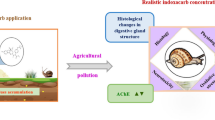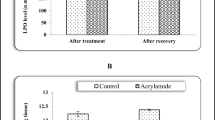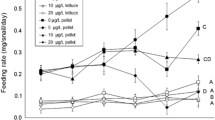Abstract
In the current study, the toxicity bioassay of three pollutants abamectin (ABM), thiamethoxam (TMX), and acrylamide (ACR) against land snails Theba pisana was measured. Also, the ecotoxicological effects of dietary exposure to sublethal concentration (1/20 LC50) of these pollutants for 2-week exposure and 1-week recovery on some physiological endpoints evaluated as feeding activity, growth response, and carbonic anhydrase activity as a marker in charge of shell formation and seromucoid level as a marker in charge of mucus synthesis of the snails were studied. The results exhibited that the 48-h LC50 values were 0.91, 313.8, and 45.7 μg/g dry food for ABM, TMX, and ACR, respectively. The sublethal concentrations of these pollutants in the diet after 2-week exposure were found to reduce the food consumption and inhibit growth rate of the snails. Also, the data illustrated that carbonic anhydrase activity was significantly decreased. On the other hand, there was a significant increase in the seromucoid level as a marker responsible for mucus synthesis in ABM- and TMX-exposed snails, while ACR showed significantly decreased level when compared to control. After 1-week recovery, the tested endpoints of treated snails were slightly repaired but still less than that of the untreated animals. The overall outcome of this investigation suggests the utility of this animal as a good bioindicator organism for ABM, TMX, and ACR exposure in pollution monitoring studies.




Similar content being viewed by others
References
Bai S, Ogbourne S (2016) Eco-toxicology effects of the avermectin family with a focus on abamectin and ivermectin. Chemosphere 154:204–214
Barker GM (2001) The Biology of Terrestrial Molluscs. CAB International, Oxon, Wallingford
Barman TE (1974) Enzyme Hand book, vol 1. Spering Velag, Berlin
Beeby A, Richmond L, Herpe F (2002) Lead reduces shell mass in juvenile garden snails (Helix aspersa). Environ Pollut 120:283–288
Botias C, David AH, Elizabeth M, Goulson D (2016) Contamination of wild plants near neonicotinoid seed-treated crops, and implications for non-target insects. Sci Total Environ 566:269–278
Çoban TA, Beydemir S, Gülçin I, Ekinci D (2007) Morphine inhibits erythrocyte carbonic anhydrase in vitro and in vivo. Biol Pharm Bull 30:2257–2261
CoStat program (2002) Microcomputer program analysis. CoHort software, Version 2.6, Monterey
Crowe TP, Smith EL, Donkin P, Barnaby DL, Rowland SJ (2004) Measurements of sub lethal effects on individual organisms indicates community-level impacts of pollution. J Appl Ecol 4:114–123
Denny MW (1983) Molecular biomechanics of mollucan mucous secretions. In: Mollusca WK, Simkiss K, Hochka PW (eds) , vol 1. Academic Press, NY, pp 341–465
El-Gendy KS, Radwan MA, Gad AF (2011) Feeding and growth responses of the snail Theba pisana to dietary metal exposure. Arch Environ Contam Toxicol 60:272–280
Erzen NK, Kolar L, Flajs VC, Kuzner J, Marc I, Pogacnik M (2005) Degradation of abamectin and doramectin on sheep grazed pasture. Ecotoxicology 14:627–635
Finney DJ (1971) Probit analysis, 3rd edn. Cambridge university press, London 318 pp
Friedman M (2003) Chemistry, biochemistry, and safety of acrylamide. A review. J Agric Food Chem 51:4504–4526
Gomot-de Vaufleury A, Bispo A (2000) Methods for toxicity assessment of contaminated soil by oral or dermal uptake in land snails. 1. Sublethal effects on growth. Environ Sci Technol 34:1865–1870
Goulson D (2013) An overview of the environmental risks posed by neonicotinoid insecticides. J Appl Ecol 50:977–987
Hasheesh WS, Mohamed RT (2011) Bioassay of two pesticides on Bulinus truncatus snails with emphasis on some biological and histological parameters. Pestic Biochem Physiol 100:1–6
Jansson RK, Dybas RA (1998) Avermectins: Biochemical mode of action, biological activity and agricultural importance. In: Ishaaya I, Degheele D (eds) Insecticides with Novel Modes of Action: Mechanisms and Application. Springer-Verlag, New York, pp 152–167
Kamble SB, Kamble NA (2014) Behavioural changes in freshwater snail Bellamya bengalensis due to acute toxicity of copper sulphate and Acacia sinuate. Int J Sci Environ Technol 3:1090–1104
Kaya ED, Söyüt H, Beydemir S (2013) Carbonic anhydrase activity from the gilthead sea bream (Sparus aurata) liver: the toxicological effects of heavy metals. Environ Toxicol Pharmacol 36:514–521
Kolar L, Jemec A, van Gestel CAM, Valant J, Hrzenjak R, Erzen NK, Zidar P (2010) Toxicity of abamectin to the terrestrial isopod Porcellio scaber (Isopoda, Crustacea). Ecotoxicology 19:917–927
Krishna G, Muralidhara (2015) Inulin supplementation during gestation mitigates acrylamide-induced maternal and fetal brain oxidative dysfunctions and neurotoxicity in rats. Neurotoxicol Teratol 49:49–58
Larguinho M, Cordeiro A, Diniz MS, Costa PM, Baptista PV (2014) Metabolic and histopathological alterations in the marine bivalve Mytilus galloprovincialis induced by chronic exposure to acrylamide. Environ Res 135:55–62
Lionetto MG, Caricato R, Giordano ME, Schettino T (2016) Carbonic anhydrase based biomarkers: potential application in human health and environmental sciences. Curr Biomarkers 6:40–46
Lowry OH, Rasebrough NJ, Farr AL, Randall RJ (1951) Protein measurement with the folin phenol reagent. J Biol Chem 193:265–275
Ma J, Li XY (2011) Acute toxicity of lambda-cyhalothrin, imidaclopid and avermectin on Physa acuta. J Hydrol 32:100–104
Maioli MA, de Medeiros HCD, Guelfi M, Trinca V, Pereira FTV, Mingatto FE (2013) The role of mitochondria and biotransformation in abamectin-induced cytotoxicity in isolated rat hepatocytes. Toxicol in Vitro 27:570–579
Marin F, Le Roy N, Marie B (2012) The formation and mineralization of mollusk shell. Front Biosci S4:1099–1125
Minakshi R, Mahajan AY (2013) Effect of thiamethoxam on oxygen consumption of the freshwater bivalve, Lamellidens marginalis (Lamarck). The bioscan 8:469–472
Mleiki A, Irizar A, Zaldibar B, El Menif NT, Marigómez I (2016) Bioaccumulation and tissue distribution of Pb and Cd and growth effects in the green garden snail, Cantareus apertus (Born, 1778), after dietary exposure to the metals alone and in combination. Sci Total Environ 547:148–156
Mohamed AM, Bakry FA, Heiba FN (2000) Effect of sublethal concentrations of Abamectin on Biomphalaria alexandrina snails and the free living stages of Schistosoma mansoni. Egyptian J Fish Biol 4:1–15
Pawlicki JM, Pease LB, Pierce CM, Startz TP, Zhang Y, Smith AM (2004) The effect of molluscan glue proteins on gel mechanics. J Exp Biol 207:1127–1135
Pisa LW, Amaral-Rogers V, Belzunces LP, Bonmatin JM, Downs CA, Goulson D, Kreutzweiser DP, Krupke C, Liess M, McField M, Morrissey CA, Noome DA, Settele J, Simon-Delso N, Stark JD, Van der Sluijs JP, Van Dyck H, Wiemers M (2015) Effects of neonicotinoids and fipronil on non-target invertebrates. Environ Sci Pollut Res 22:68–102
Pryce JD (1967) Simplified microestimation of fibrinogen and seromucoid in plasma. Clin Chem 13:650–657
Radwan MA (2016) Comparative toxic effects of some pesticides with different modes of action against the land snail, Theba pisana. Int J Zool Invest 2:170–176
Radwan MA, El-Gendy KS, Gad AF (2010) Biomarkers of oxidative stress in the land snail, Theba pisana for assessing ecotoxicological effects of urban metal pollution. Chemosphere 79:40–46
Ramakrishnan N (2003) Bio-monitoring approaches for water quality assessment in two waterbodies at Tiruvannamalai, Tamil Nadu India. In: Proceedings of the 3rd Int Conf Environ Health, Chennai, India, 15-17 December, pp 374 – 385.
Regoli F, Gorbi S, Fattorini D, Tedesco S, Notti A, Machella N, Bocchetti R, Benedetti M, Piva F (2006) Use of the land snail Helix aspersa as sentinel organism for monitoring ecotoxicologic effects of urban pollution: an integrated approach. Environ Health Perspect 114:63–69
Rodríguez-Eugenio N, McLaughlin M, Pennock D (2018) Soil Pollution: a hidden reality. FAO, Rome pp 142
Santini O, Chahbane N, Vasseur P, Frank H (2011) Effects of low-level copper exposure on Ca2+-ATPase and carbonic anhydrase in the freshwater bivalve Anodonta anatine. Toxicol Environ Chem 93:1826–1837
Schuytema GS, Nebeker AV, Griffis WL (1994) Effects of dietary exposure to forest pesticides on the brown garden snail Helix aspersa Müller. Arch Environ Contam Toxicol 26:23–28
Scott DM, Major CW (1972) The effect of copper (II) on survival, respiration, and heart rate in the common blue mussel, Mytilus edulis. Biol Bull 143:679–688
Snyman RG, Reinecke AJ, Reinecke SA (2002) Field application of a lysosomal assay as biomarker of copper oxychloride exposure, in the snail Helix aspersa. Bull Environ Contam Toxicol 69:117–122
Subaraja M, Vanisree AJ (2015) Cerebral ganglionic variations and movement behaviors of Lumbricus terrestris on exposure to neurotoxin. Ann Neurosci 22:199–207
Sun Y, Diao X, Zhang Q, Shen J (2005) Bioaccumulation and elimination of avermectin B1a in the earthworms (Eisenia foetida). Chemosphere 60:699–704
Swaileh KM, Ezzughayyar A (2000) Effects of dietary Cd and Cu on feeding and growth rates of the land snail Helix engaddensis. Ecotoxicol Environ Saf 47:253–260
Swaileh KM, Ezzughayyar A (2001) Dose-dependent effects of dietary Pb and Zn on feeding and growth rates of the land snail, Helix engaddensis. Ecotoxicol Environ Saf 50:9–14
Tomizawa M, Casida JE (2003) Selective toxicity of neonicotinoids attributable to specificity of insect and mammalian nicotinic receptors. Annu Rev Entomol 48:339–364
Triebskom R, Ebert D (1989) The importance of mucus production in slug's reaction to molluscicides and the impact of molluscicides on the mucus producing system. In: Henderson IF (ed) Slugs and Snails in World Agriculture. BCPC Monograph 41, Thornton Heath, pp 373–379
Triebskorn R, Henderson IF, Martin A, Kohler H-R (1996) Slugs as targets or non-target organisms for environmental chemicals. In: Henderson IF (ed) Slug and Snail Pests in Agriculture. BCPC Monograph 66, Farnharm, pp 65–72
Wilbur KM, Saleuddin ASM (1983) Shell formation. In: Saleuddin ASM, Wilbur KM (eds) The Mollusca, vol 4. Academic Press, New York, pp 235–287
Wojtaszek J, Poloczek-Adamowicz A, Adamowicz A, Fuks U, Dzugaj A (1998) Cytomorphometry and seromucoid concentration in the hemolymph of selected snail species. Zoologica Poloniae 43:87–101
Wood TJ, Goulson D (2017) The environmental risks of neonicotinoid pesticides: a review of the evidence post 2013. Environ Sci Pollut Res 24:17285–17325
Author information
Authors and Affiliations
Corresponding author
Ethics declarations
Conflict of interest
The authors declare that they have no competing interests.
Additional information
Responsible editor: Philippe Garrigues
Publisher’s note
Springer Nature remains neutral with regard to jurisdictional claims in published maps and institutional affiliations.
Rights and permissions
About this article
Cite this article
El-Gendy, K.S., Radwan, M.A., Gad, A.F. et al. Physiological traits of land snails Theba pisana as simple endpoints to assess the exposure to some pollutants . Environ Sci Pollut Res 26, 6922–6930 (2019). https://doi.org/10.1007/s11356-019-04180-8
Received:
Accepted:
Published:
Issue Date:
DOI: https://doi.org/10.1007/s11356-019-04180-8




